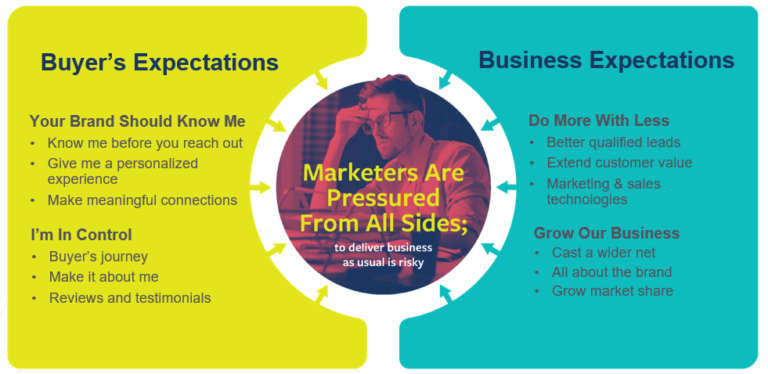30-second summary:
- Lifecycle is a more holistic view of the customer journey – accounting for post-purchase touchpoints such as: adoption, retention, expansion, and advocacy
- Increasingly, customers are expecting engagement in this context. And business leaders are expecting marketers to leverage this space
- Greenberg’s best practices include: tracking digital behaviors, defining segments pre- and post-acquisition, engaging around your offering, and developing advocacy programs
September 17 saw ClickZ host a webinar by David Greenberg, SVP of marketing at Act-On. The presentation really dug into lifecycle marketing best practice.
Greenberg also highlighted how the lifecycle approach differs from the more traditional funnel approaches to thinking about customer journeys, and shows how the old ways are simply not enough when looking at marketing strategies in today’s omnichannel world.
Here are our takeaways:
The differences between funnel and lifecycle marketing
Greenberg points out that the best way to begin to understand how lifecycle marketing is different from, and improves upon, funnel marketing is to go back to what we know about the traditional customer journey.
Funnel marketing is primarily concerned with customer acquisition through sparking awareness, generating intent, and concluding in a sale/conversion.
Greenberg highlights that in this context segmentation will be geared towards understanding buyer behavior, martech will mostly be deployed to help with lead nurturing, and the practice will largely be the domain of sales and marketing teams.
Lifecycle doesn’t ignore this vital part of the funnel. But (Read more...) looks at what happens after purchase too.
There are other steps, here, that the user is or could be taking. And there is tremendous opportunity for engagement across:
- Adoption: welcoming, starting to use the product
- Retention: engendering trust in brand/product
- Expansion: upselling, cross-selling
- Advocacy: elevating the voices of those who have authentic love of the brand/product
‘This latter half needs to run like an engine,’ Greenberg says. ‘Marketers need to think about the funnel holistically.’
Why funnel marketing isn’t enough anymore
As we start to understand how the lifecycle marketing journey differs from the funnel, it becomes quite easy to see why the latter falls short today.
According to Podium, 93% of consumers say online reviews impact purchasing decisions. As a post-purchase opportunity, or touchpoint, advocacy is undoubtedly growing in value while traditional ways of reaching people (i.e. ads) are becoming less effective and more expensive.
Greenberg also points to a plethora of new expectations among buyers and businesses.
Things like personalization, authenticity, and meaningful connections are increasingly expected by consumers. While business owners are expecting marketers to do more with less, as well as trying to get more value from their customers.
Four lifecycle marketing best practices
So how do we start to plan and strategize lifecycle marketing? Greenberg offers the following four best practice steps:
1) Track digital behaviors
Awareness to purchase is relatively well covered, but what about post-purchase tracking?
The software vertical is a good example. Are customers looking for help as they set up their product? Are they using it right? Are they logging in and taking action?
Engaging here is helpful. And brands can also begin to identify who are enthusiastic customers (and who aren’t) at this stage.
2) Define segments pre- and post-acquisition
With the data from step one, brands can segment out consumers from post-purchase activity as well as their pre-purchase activity. Segments might include:
- Engaged / not-engaged
- Regular purchasers / infrequent purchasers
- Responsive users / not-responsive users
- Loyal customers / not loyal
Greenberg cites the hotel sector as a good example here – with different rewards streams designed for active members and less-active ones.
3) Engage around your offering
Onboarding and training with the use of digital cues can help customers adopt and use the product.
Communications need to be timely, here. Importantly, in-touch/proactive customer support can help improve experiences, boost expansion, and drive renewals.
4) Develop advocacy programs
Who are your advocates? And how do you elevate their voices?
Incentivize advocates and fans to post reviews on neutral sites. But Greenberg stresses: these incentives must be reasonable, and the goal must be to drive authentic reviews.
Takeaways
The purchase funnel has changed a great deal in the past ten years. A sale or conversion is no longer the end of the story and lifecycle marketing is an important way for brands to make the most of the new opportunities available in the post-purchase part of the journey.
It is very much a tidal shift. As more and more brands tap into engaging with customers across the adoption, expansion, retention, and advocacy touchpoints, then a growing number of buyers begin to expect those experiences from others.
Likewise, business leaders are keen to compete with the market leaders, and they are putting pressure on marketing teams to understand customer lifetime value as well as growing the brand.
The good news is that lifecycle marketing best practice techniques are not hard to achieve. The martech is there. But it is also knowing how to implement it and using it to understand the nuances of the post-purchase experience of your particular customers.
Gathering post-purchase data and using it to segment in this context informs how you engage with these consumers, find your advocates, and ensure that they have the platform and the incentive to share why they love your brand and your customer experience.


